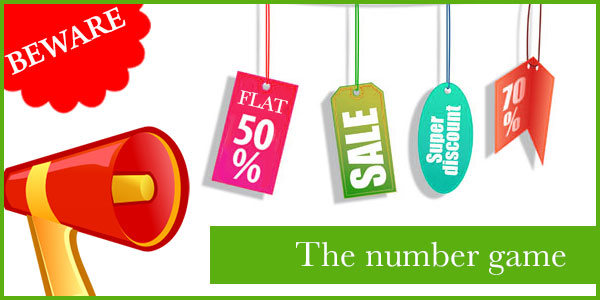There is a popular adage called "fool me once, shame on you; fool me twice, shame on me". However, if you're duped third time also, then it implies you really love to shop a lot. Retailers know how to play number game perfectly. Advertisements and smart pricing techniques are a few tricks that retailers play to dupe consumers. What the retailers do are completely legal and ethical. They're not compelling you to buy anything. You're purchasing stuffs out of your own choice. It's another matter that you may feel tricked after a while.
Here are the 5 most common ways retailers dupe consumers and entice them to buy stuffs.
1. "Up to" offers: There is a big difference between "flat 50%" and "up to 50%" discount. In case of "flat 50%" discount, you'll get a particular item at half price. This means if the cost of a particular item is $500, then you can get it by paying only $250. However, when the retailer is giving "up to 50% discount", it doesn't imply that you'll get the item at half price. The discount offer is between 1% and 50%. So, don't get shocked if you see that retailer is giving only 10% discount on a particular item.
2. "Auspicious number 9": Retailers love the number 9. Most of them would charge a price that ends with nine. For instance, a $39 dress. The buyer would think that the price of the dress is less than $40. What the buyer doesn't realize is that fact that he is paying only $1 less than $40. So, it's almost paying $40 only.
3. "Price anchoring": When you buy a $60 dress on sale for only $45, your heart jumps with joy. You just feel at the top of the world. You just take that dress in your hand and buy it instantly. What you don't think is that the retailer never ever planned to sell that dress at $60. His original plan was to sell the dress at $45 only. This trick is called "price anchoring".
4. "Leaving dollar sign": As per a study, consumers spend more when dollar signs are not given in the menu. Sometimes, restaurants deliberately highlight costly items knowing fully well that you won't opt for them. However, other items appear to be moderately priced in comparison. So, you're more likely to buy them, although they're in actuality not cheap.
5. "Ten items for $10": You must have seen the sign in the grocery store - ten items for $10. Once you see the placard, you end up buying ten items all at once. You may not need all the ten items now, but still you buy them just for the sake of the offer. What you forget or are not aware of is the fact that you can purchase any one item at only $1.
Often consumers don't pay attention to what they are actually buying. For instance, sometimes you buy ice creams from stores. You lick it without realizing that ice cream makers have slashed the cream content so much that it can no longer be labelled as ice cream. It is only a dairy product. The phrase 'dairy product' does not appear in the ice cream cover. So, people hardly realize that they are not gobbling real ice cream.













